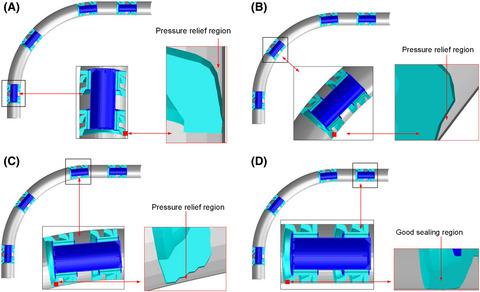当前位置:
X-MOL 学术
›
Energy Sci. Eng.
›
论文详情
Our official English website, www.x-mol.net, welcomes your
feedback! (Note: you will need to create a separate account there.)
Numerical investigation on sealing performance of drainage pipeline inspection gauge crossing pipeline elbows
Energy Science & Engineering ( IF 3.5 ) Pub Date : 2021-08-05 , DOI: 10.1002/ese3.955 Jinxu Jiang 1 , Hong Zhang 1 , Beilei Ji 1 , Feining Yi 2 , Feng Yan 2 , Xiaoben Liu 1, 2
Energy Science & Engineering ( IF 3.5 ) Pub Date : 2021-08-05 , DOI: 10.1002/ese3.955 Jinxu Jiang 1 , Hong Zhang 1 , Beilei Ji 1 , Feining Yi 2 , Feng Yan 2 , Xiaoben Liu 1, 2
Affiliation

|
A pipeline inspection gauge (PIG) is routinely passed throughout the long-distance oil and gas pipelines by pipeline operators to clean the pipeline. Sealing performance is a significant evaluation index for PIG's safety operation. To comprehensively evaluate the PIG's seal performance, nonlinear finite element models were developed, and parametric analysis was conducted in this study. The accuracy of simulation model was validated from numerical and experimental results reported in the literature. The results show that comparing with the pigging in straight pipes, the sealing rubber cups of PIGs can be more easily detached from the pipe wall when passing through elbows, causing smaller sealing areas. For a typical elbow (with curvature radius equals to six times of pipe diameter) widely used in pipeline industry, the minimum sealing area of rubber cup is only 8.07% during common operation conditions. The sealing ability of rubber cups can be obviously enhanced by increasing the curvature radius for the pigging operation of small curvature elbow. Elbow radius slightly affects the cup's sealing behavior when the curvature radius is over six times of pipe's outer diameter. An increment in sealing cup interference can increase the contact area between cup and pipe wall, and the blockage risk of PIGs will be reduced due to the good sealing ability and sufficient driving force. The minimum interference required for the cups is 4% under a most common operation condition; that is, the sealing cup thickness, fluid pressure difference, and friction coefficient are 35 mm, 0.02 MPa, and 0.3, respectively. A proper decrease in sealing cup thickness will reduce the stiffness of rubber cups, indicating that the cups with a smaller thickness are more prone to deformation. Thus, an increase in differential pressure over PIG can enhance the sealing performance of cups when the cups are separated from pipe wall. A large friction coefficient is risky for a safe pigging due to the decrease in sealing region with the increase in friction coefficient. In engineering practice, proper measures should be taken to reduce friction force. Above all, the results obtained in this study provide a reference for the structural design of PIGs.
中文翻译:

排水管道检具穿越管道弯头密封性能数值研究
管道运营商通常会在整个长距离油气管道中通过管道检查表 (PIG) 来清洁管道。密封性能是PIG安全运行的重要评价指标。为了全面评估 PIG 的密封性能,开发了非线性有限元模型,并在本研究中进行了参数分析。从文献中报道的数值和实验结果验证了模拟模型的准确性。结果表明,与直管中的清管相比,PIG的密封胶杯在通过弯头时更容易脱离管壁,密封面积更小。对于管道行业中广泛使用的典型弯头(曲率半径等于管径的六倍),橡胶杯的最小密封面积在一般工况下仅为8.07%。小曲率弯头清管作业时,增大曲率半径可明显提高胶杯的密封能力。当曲率半径超过管道外径的六倍时,弯头半径会轻微影响杯的密封性能。密封杯过盈量的增加可以增加杯与管壁的接触面积,并且由于密封能力好和驱动力足够,PIGs的堵塞风险会降低。在最常见的操作条件下,杯子所需的最小干扰为 4%;即密封杯厚度、流体压差和摩擦系数分别为 35 mm、0.02 MPa 和 0.3。适当减小密封杯厚度会降低橡胶杯的刚度,说明厚度较小的密封杯更容易变形。因此,当杯子与管壁分离时,PIG 上压差的增加可以增强杯子的密封性能。由于随着摩擦系数的增加密封区域的减小,较大的摩擦系数对于安全清管是有风险的。在工程实践中,应采取适当的措施来减小摩擦力。最重要的是,本研究获得的结果为 PIG 的结构设计提供了参考。当杯子与管壁分离时,增加 PIG 上的压差可以提高杯子的密封性能。由于随着摩擦系数的增加密封区域的减小,较大的摩擦系数对于安全清管是有风险的。在工程实践中,应采取适当的措施降低摩擦力。最重要的是,本研究获得的结果为 PIG 的结构设计提供了参考。当杯子与管壁分离时,增加 PIG 上的压差可以提高杯子的密封性能。由于随着摩擦系数的增加密封区域的减小,较大的摩擦系数对于安全清管是有风险的。在工程实践中,应采取适当的措施来减小摩擦力。最重要的是,本研究获得的结果为 PIG 的结构设计提供了参考。
更新日期:2021-10-03
中文翻译:

排水管道检具穿越管道弯头密封性能数值研究
管道运营商通常会在整个长距离油气管道中通过管道检查表 (PIG) 来清洁管道。密封性能是PIG安全运行的重要评价指标。为了全面评估 PIG 的密封性能,开发了非线性有限元模型,并在本研究中进行了参数分析。从文献中报道的数值和实验结果验证了模拟模型的准确性。结果表明,与直管中的清管相比,PIG的密封胶杯在通过弯头时更容易脱离管壁,密封面积更小。对于管道行业中广泛使用的典型弯头(曲率半径等于管径的六倍),橡胶杯的最小密封面积在一般工况下仅为8.07%。小曲率弯头清管作业时,增大曲率半径可明显提高胶杯的密封能力。当曲率半径超过管道外径的六倍时,弯头半径会轻微影响杯的密封性能。密封杯过盈量的增加可以增加杯与管壁的接触面积,并且由于密封能力好和驱动力足够,PIGs的堵塞风险会降低。在最常见的操作条件下,杯子所需的最小干扰为 4%;即密封杯厚度、流体压差和摩擦系数分别为 35 mm、0.02 MPa 和 0.3。适当减小密封杯厚度会降低橡胶杯的刚度,说明厚度较小的密封杯更容易变形。因此,当杯子与管壁分离时,PIG 上压差的增加可以增强杯子的密封性能。由于随着摩擦系数的增加密封区域的减小,较大的摩擦系数对于安全清管是有风险的。在工程实践中,应采取适当的措施来减小摩擦力。最重要的是,本研究获得的结果为 PIG 的结构设计提供了参考。当杯子与管壁分离时,增加 PIG 上的压差可以提高杯子的密封性能。由于随着摩擦系数的增加密封区域的减小,较大的摩擦系数对于安全清管是有风险的。在工程实践中,应采取适当的措施降低摩擦力。最重要的是,本研究获得的结果为 PIG 的结构设计提供了参考。当杯子与管壁分离时,增加 PIG 上的压差可以提高杯子的密封性能。由于随着摩擦系数的增加密封区域的减小,较大的摩擦系数对于安全清管是有风险的。在工程实践中,应采取适当的措施来减小摩擦力。最重要的是,本研究获得的结果为 PIG 的结构设计提供了参考。











































 京公网安备 11010802027423号
京公网安备 11010802027423号